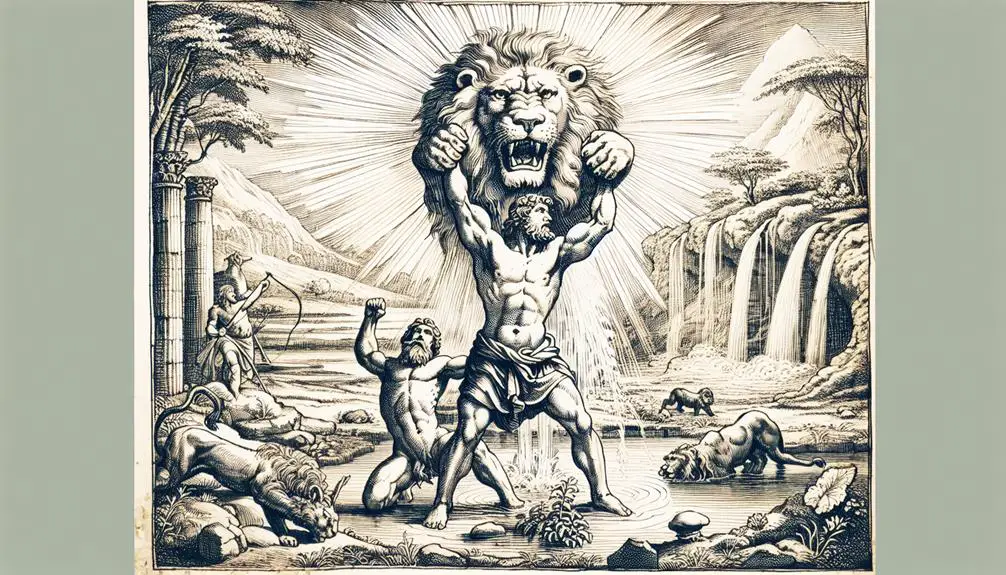Why does the tale of En-Hakkore captivate us, revealing profound lessons on faith, desperation, and divine grace in the Bible's pages?

En-Hakkore in the Bible
In the sands of time, stories remain; in the pages of the Bible, lessons endure.
You might find the tale of En-Hakkore intriguing, nestled within the larger narrative of Samson, a figure of immense strength and complex faith. This spot, named by Samson himself, signifies a moment of divine intervention and personal desperation.
But what does it truly mean, and why does it hold a place of significance in biblical history and beyond? As you explore the layers of this story, you'll uncover insights into faith, miracles, and the human spirit that still resonate today.
Why does En-Hakkore's story matter to us, now?
Key Takeaways
- En-Hakkore symbolizes divine response to human desperation, emphasizing faith's role in accessing divine provision.
- The narrative reflects themes of faith, providence, and the dynamic between divine power and human need.
- En-Hakkore's story offers lessons on perseverance and faith in adversity, applicable to both personal and community spirituality.
- The account enriches biblical understanding, highlighting the importance of cultural and historical context in interpreting divine-human interactions.
The Story of Samson

The story of Samson, a narrative rich in themes of strength, betrayal, and redemption, showcases the complexities of divine providence and human fallibility. You'll find that Samson's strength, a divine gift, serves as a pivotal element in the unfolding drama, particularly in his skirmishes against the Philistines. This extraordinary power not only underscores the miraculous interventions of the divine in the affairs of humans but also highlights the tragic flaws inherent in Samson's character.
Analyzing Samson's confrontations with the Philistines offers insights into the period's socio-political turmoil. Samson's exploits, including slaying a lion with his bare hands, massacring Philistines with the jawbone of a donkey, and toppling the temple of Dagon, aren't merely acts of personal vengeance. They symbolize the ongoing struggle for Hebrew autonomy against Philistine oppression. Yet, these same narratives reveal a man ensnared by personal failings—pride, vengeance, and susceptibility to deceit—which ultimately lead to his downfall.
Samson's strength and his battles against the Philistines thus serve dual purposes: they're manifestations of divine intervention and reflections of human vulnerability. This duality underscores the broader theological and moral questions the narrative addresses, particularly concerning the nature of strength, the consequences of betrayal, and the possibility of redemption despite profound failings.
In examining Samson's story, you're invited to ponder the paradoxes of human existence: the coexistence of strength and weakness, the interplay between divine will and human agency, and the intricate dance of fate and free will. Through this lens, Samson's saga transcends its ancient origins, offering timeless reflections on the human condition.
Meaning of En-Hakkore

What does the term 'En-Hakkore' signify within the biblical narrative, and how does its meaning illuminate aspects of divine provision and human desperation? In the story, En-Hakkore is depicted as a miraculous spring, its name translating to "the spring of the caller" or "the spring of one who cries out," emphasizing the interaction between human need and divine response. This location is not just a geographical point but a testament to the power of faith and the immediacy of divine intervention in times of dire need.
The spring's origin, tied to a moment of desperation, highlights a profound aspect of divine provision—where physical and spiritual sustenance are granted in response to human appeal. This interplay between divine provision and human desperation is further underscored by the geographical location of En-Hakkore, which is situated in a region otherwise noted for its arid conditions, symbolizing a place of relief and renewal amidst adversity.
Aspect |
Insight |
|---|---|
Name Meaning |
"The spring of the caller" – a cry for divine intervention |
Divine Provision |
A response to human desperation, offering sustenance |
Geographical Location |
Symbolizes relief in adversity, highlighting the importance of faith |
Spring's Origin |
Tied to a moment of human need, showcases divine responsiveness |
Analyzing the meaning of En-Hakkore offers a profound understanding of how divine provision can emerge from moments of human desperation, underscoring faith's role in accessing such providence. The name and its story encapsulate a timeless message of hope and renewal, deeply embedded within the geographical and spiritual landscape of the narrative.
Biblical Significance

In exploring the biblical significance of En-Hakkore, it's crucial to understand how this narrative element reflects broader themes of faith, providence, and human interaction with the divine. The story, nestled within the larger tapestry of scriptural accounts, offers a lens through which to examine the intricate relationship between God and humanity, underscored by episodes such as Jephthah's vow and Balaam's prophecy.
Jephthah's vow, a solemn promise made to secure divine favor in battle, underscores the gravity with which vows were treated in biblical times and highlights the complexities of human-divine negotiations. It illustrates the lengths to which individuals went to invoke God's intervention, revealing deep-seated beliefs in the power of covenantal agreements. Similarly, Balaam's prophecy serves as a testament to the belief in divine communication and guidance. This narrative, featuring a non-Israelite prophet's interaction with God, broadens the scope of divine engagement beyond the Israelite community, suggesting a universal aspect to God's reach and concern.
These stories, while distinct, converge in their portrayal of a God who's deeply involved in the affairs of the world, responding to human actions and pleas in ways that are both direct and mysterious. En-Hakkore, as a symbol of divine provision and presence, fits seamlessly into this theme, representing a tangible manifestation of God's responsiveness to human need.
Analyzing En-Hakkore within this context underscores its significance not merely as a historical or geographical detail but as a narrative device that enriches our understanding of the divine character. It invites contemplation on the nature of faith, the intricacies of divine-human interaction, and the enduring belief in a providential God who meets human desperation with miraculous provision.
Lessons of Faith

Reflecting on En-Hakkore's narrative reveals profound lessons about the nature of faith, particularly its role in shaping human understanding of divine intervention. This story, rooted deep within biblical lore, serves as a vivid tableau illustrating the dynamic interplay between human desperation and divine response. It underscores a pivotal aspect of faith: the belief in divine intervention amidst personal struggles.
Your journey through En-Hakkore's tale illuminates the multifaceted character of faith. It's not merely an abstract belief in the supernatural but a lived experience that molds your perception of the divine's role in the human saga. Here, faith emerges as a beacon, guiding individuals through their darkest hours to seek and witness divine intervention.
This narrative also offers a critical lens through which you can examine the nature of personal struggles. It suggests that these challenges aren't devoid of purpose or meaning. Instead, they're intricately connected to the broader tapestry of divine will, serving as catalysts for the manifestation of divine intervention. Your understanding of these struggles, therefore, isn't just about endurance but about recognizing and embracing the potential for divine intercession.
Furthermore, En-Hakkore's story teaches you that faith necessitates an active engagement with one's circumstances, urging you to seek out divine intervention rather than passively awaiting rescue. It's a compelling reminder that faith, in its essence, involves a dual commitment: a steadfast belief in divine power and a proactive stance in the face of personal adversities.
In essence, the lessons of faith derived from En-Hakkore's narrative are both timeless and transformative, offering profound insights into the relationship between divine intervention and personal struggles.
Modern Reflections

Frequently, modern believers encounter narratives like En-Hakkore's, which challenge them to reinterpret ancient lessons of faith within the complexities of contemporary life. This process of reinterpretation isn't merely academic but deeply personal, involving a critical engagement with the text that respects its historical context while seeking relevance in today's world.
As you navigate this landscape, consider the following dimensions:
- Cultural adaptation: How does the story of En-Hakkore speak to modern issues of cultural identity and adaptation?
- Historical interpretations: What insights can be gained by examining how interpretations of En-Hakkore have evolved over time?
- Faith in practice: How can the principles embodied in the En-Hakkore narrative guide daily living and decision-making in a modern context?
- Community and spirituality: What role does the story of En-Hakkore play in fostering community bonds and spiritual growth in contemporary settings?
These points underscore the necessity of a dynamic engagement with biblical texts, where cultural adaptation and historical interpretations enrich understanding and application. This analytical approach allows you to appreciate the depth of the narratives and the multifaceted lessons they offer.
Frequently Asked Questions
How Do Archaeological Findings Support or Contradict the Existence and Location of En-Hakkore?
You're exploring how archaeological methods shed light on the existence and location of En-Hakkore, moving beyond spring myths. By examining artifacts, structures, and settlement patterns, archaeologists piece together evidence that either supports or contradicts historical accounts.
This objective, scholarly analysis hinges on comparing archaeological data with ancient narratives. Yet, despite rigorous investigation, the direct connection to En-Hakkore remains elusive, highlighting the complex interplay between myth and material evidence in unraveling the past.
Are There Any Cultural or Religious Practices Today That Trace Their Origins Back to the Story of En-Hakkore?
Are you curious about how ancient stories shape modern practices?
Today, some cultural and religious rituals subtly echo the tales of old, including the story of Samson's strength.
While direct links to En-Hakkore mightn't be overt, the celebration of strength and perseverance in various religious practices can be traced back to such narratives.
These rituals remind us of the enduring impact of historical and mythical events on contemporary cultural and spiritual life.
What Linguistic or Etymological Connections Does En-Hakkore Have With Other Names or Places in Ancient Semitic Languages?
You're exploring the linguistic ties of En-Hakkore with ancient Semitic languages, focusing on Semitic root analysis and name symbolism. This approach reveals deep connections.
Semitic root analysis uncovers commonalities in phonetics and meanings, suggesting shared cultural or religious significance.
Name symbolism further enriches this understanding, highlighting how names encapsulate beliefs, values, or historical events.
Together, these methods offer a comprehensive view of En-Hakkore's etymological and cultural place in ancient Semitic traditions.
How Has the Story of En-Hakkore Been Depicted in Art, Literature, and Media Throughout History?
Interestingly, you've likely seen modern interpretations of this story, perhaps without even realizing it. From paintings to novels, its themes resonate widely. Cinematic adaptations have brought it to life on screen, showcasing the depth and complexity of its narrative.
Scholars analyze these portrayals, noting how each medium adds its own layer of interpretation. This evolution in art, literature, and media highlights its enduring impact, making it a fascinating study of cultural adaptation and reinterpretation.
What Are the Ecological or Geographical Features of the Region Traditionally Identified as En-Hakkore, and How Have They Changed Over Time?
You're exploring the ecological or geographical features of a region, focusing on water sources and vegetation types. Over time, these features have likely experienced significant changes due to natural and human-induced factors.
You'll find that water sources may have shifted, affecting local vegetation patterns. Analyzing historical data, you can trace how these elements have evolved, providing insights into the environmental dynamics of the area.
This analysis is crucial for understanding its ecological history.
Conclusion
Ironically, while you've delved deep into the layers of En-Hakkore, sifting through ancient texts and theological interpretations, the essence boils down to something quite contemporary: the thirst for redemption and strength.
Despite the antiquity, Samson's plea at En-Hakkore mirrors our own modern quests for spiritual resilience. So, as you reflect on this biblical narrative, remember, the search for divine intervention in moments of despair is as age-old as it's refreshingly relevant.
Who knew ancient tales could hold the mirror to our present?



Sign up